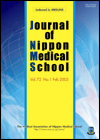Volume 91, Issue 5
Displaying 1-14 of 14 articles from this issue
- |<
- <
- 1
- >
- >|
Originals
-
2024Volume 91Issue 5 Pages 426-431
Published: October 25, 2024
Released on J-STAGE: November 06, 2024
Download PDF (151K) -
2024Volume 91Issue 5 Pages 432-438
Published: October 25, 2024
Released on J-STAGE: November 06, 2024
Download PDF (138K) -
2024Volume 91Issue 5 Pages 439-445
Published: October 25, 2024
Released on J-STAGE: November 06, 2024
Download PDF (96K) -
2024Volume 91Issue 5 Pages 446-456
Published: October 25, 2024
Released on J-STAGE: November 06, 2024
Download PDF (390K) -
2024Volume 91Issue 5 Pages 457-464
Published: October 25, 2024
Released on J-STAGE: November 06, 2024
Download PDF (90K) -
2024Volume 91Issue 5 Pages 465-471
Published: October 25, 2024
Released on J-STAGE: November 06, 2024
Download PDF (670K) -
2024Volume 91Issue 5 Pages 472-479
Published: October 25, 2024
Released on J-STAGE: November 06, 2024
Download PDF (121K) -
2024Volume 91Issue 5 Pages 480-487
Published: October 25, 2024
Released on J-STAGE: November 06, 2024
Download PDF (588K) -
2024Volume 91Issue 5 Pages 488-494
Published: October 25, 2024
Released on J-STAGE: November 06, 2024
Download PDF (83K)
Case Reports
-
2024Volume 91Issue 5 Pages 495-498
Published: October 25, 2024
Released on J-STAGE: November 06, 2024
Advance online publication: June 02, 2023Download PDF (67K) -
2024Volume 91Issue 5 Pages 499-501
Published: October 25, 2024
Released on J-STAGE: November 06, 2024
Download PDF (162K) -
2024Volume 91Issue 5 Pages 502-507
Published: October 25, 2024
Released on J-STAGE: November 06, 2024
Download PDF (820K) -
2024Volume 91Issue 5 Pages 508-511
Published: October 25, 2024
Released on J-STAGE: November 06, 2024
Download PDF (650K) -
2024Volume 91Issue 5 Pages 512-517
Published: October 25, 2024
Released on J-STAGE: November 06, 2024
Advance online publication: August 08, 2023Download PDF (661K)
- |<
- <
- 1
- >
- >|
